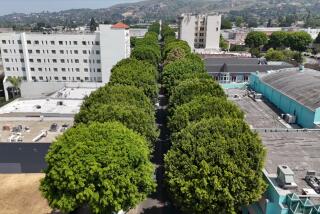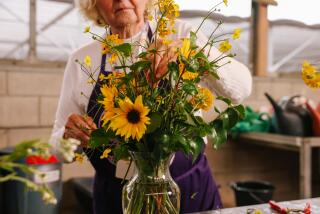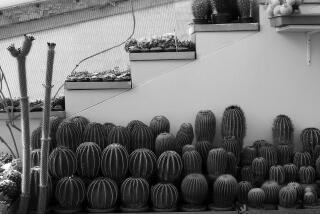Misdiagnosis at Root of This Problem
- Share via
Let’s start off with a couple of Ficus benjamina questions a little different from the usual “leaf-dropping complaints”:
QUESTION: I have an 8-inch F. benjamina with a braided trunk that has sticky leaves. I have had it more than two years, but for the past year I have been treating it with a volck oil spray for what I’ve been told is “scale.” It only improves the condition but doesn’t cure it. Can you recommend a stronger insecticide that might be more effective?
ANSWER: First things first. Your tree does not have scale. Scale is easily detectable as shiny little brown oval objects that attach themselves to the branches and leaves of the tree.
If there’s a darkish dust on the undersides of the sticky leaves, your tree has most likely been attacked by red spider mites, which often leave behind a sticky residue. It’s also possible that your weeping fig, which is a member of the rubber tree family, is simply weeping its sticky sap.
Presuming, however, that your problem is red spider mites, the solution (literally) is malathion. You’ll never rid your tree of these pests without a systemic, an insecticide that goes into the soil to kill the eggs. Use sparingly according to directions on the bottle and, if possible, take the tree outside to apply the solution. Malathion has a horrible odor best not left in your house.
Q: I have problems with my F. benjaminas. Sometimes red berries appear on the branches, and almost inevitably the trees do poorly after that. Usually they die within a year. What gives?
A: Beats me. The red berries you describe are the seed pods, which one rarely sees on F. benjaminas that are being grown indoors. In that respect, you’re quite lucky, because any time a foliage plant (such as Chinese evergreen, philodendron or dracena) produces either blossoms or seed pods indoors, it’s a bonus. But there is absolutely no botanical connection between the seeds appearing and the trees dying.
Is it possible you are mistaking the frequent seasonal defoliation of weeping fig trees with the trees, dying?
Next time this happens--if it does--bend the twigs and branches of the tree. If they’re supple, give the tree a chance to recover and let me know what happens. Good luck.
Transplanting Palms Makes His Palms Sweat
Q: Speaking of palms pooping, please clear up my problem: After living in my house with three king palms for 17 years, all of a sudden they started dropping seeds that became baby palms. Now, after three years, some of those babies are 5 feet tall.
I want to transplant some or all of them, but a nurseryman told me I can’t transplant king palms or they will die. Is this true or is there some special way to save them? They’re too beautiful to kill.
A: First, I wouldn’t be surprised if your king palms (Archontophoenix) are actually queen palms (Cocos plumosa), because king palms are rare and difficult to grow “in captivity.”
But either way, my answer is the same: All palms are subject to some transplant shock, especially their royal highnesses, the king and queen palms, so be sure to add a couple of teaspoons of vitamin B-1 or the recommended amount of any commercial transplant shock preventive when you first water your transplant. That will help.
Most important, transplant the palms only when the weather is warm. If you transplant them during the winter, the operation will surely fail.
Finally, don’t be afraid to experiment with your plants. Transplant one of your baby palms and see what happens.
You know the old saying: “You can’t win it if you’re not in it.”
Plants Are Faltering From the House’s Heat
Q: We just moved into a new house. I bought a whole bunch of beautiful plants--ferns, palms and the like--and in a matter of two or three weeks, they all turned brown and look terrible. I keep them in a south-facing enclosed patio. The patio has lots of windows and a double glass door, so they get lots of light. Could this problem be caused by lack of humidity?
A: Although lack of humidity (dry heat) is generally the cause of brown tips on the ends of the leaves, it sounds more like your plants are dying from the heat--literally. A south-facing enclosed glass patio probably turns into an oven in the afternoon, and the combination of heat, sunlight magnified through glass, improper to no air circulation and lack of humidity will do in most foliage plants very quickly.
You’re either going to have to provide some window coverings (expensive and a hassle), put in a greenhouse-type humidifying system (ridiculous), get some artificial plants (out of the question!) or replace the foliage plants with cactus and succulents.
It’s a matter of aesthetics. Lots of people don’t like the look of cactus and succulents, but if you do, it sounds like you’ve got a perfect spot to create a dynamic and interesting cactus and succulent “garden.”
Are your palms pooping? Are your ferns flopping? Send your houseplant questions to the Indoor Gardener in care of the Real Estate section, Los Angeles Times, Times Mirror Square, Los Angeles CA 90053.






